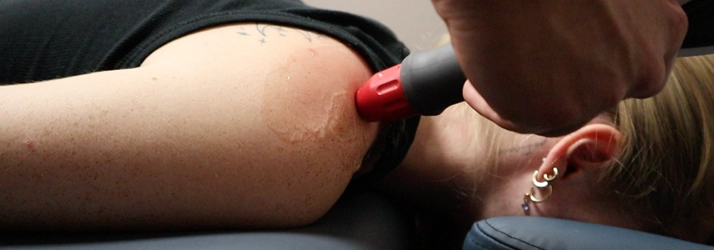How To Treat Rotator Cuff Injuries in Towson

Rotator cuff tears and other shoulder injuries in Towson are common and they're both painful and disruptive. We take all the things our shoulders do for us for granted. You don't think about getting something out of a cupboard or brushing your hair until you can't do that without pain any longer.
In the article below, Dr. Shackleton treats Mark who had a full rotator cuff tear. He had surgery 3 months ago and has been doing physical therapy but he still doesn't have his full range of motion back so we're doing dry needling and range of motion exercises to improve that.
What Is A Rotator Cuff in Towson?
Your rotator cuff is made up of muscles and tendons that keep the ball of your upper arm bone (humerus) in your shoulder socket. It also helps you raise and rotate your arm. Your rotator cuff protects your shoulder joint and makes it possible for you to move your arms over your head. You use your rotator cuff in everyday activities like reaching over your head to grab something or comb your hair and you also use it in sports like swimming, basketball, and golf.
Rotator cuff injuries are common among athletes as well as people of all activity levels over the age of 40. As we age, we are at greater risk of injuries like a rotator cuff injury due to loss of elasticity and degeneration. If you have a job that requires you to move your arms above your head in a repetitive way like a painter or carpenter, that can put you at additional risk of rotator cuff injuries.
A rotator cuff tear is often the result of wear and tear from daily use. Most tears are partial but in Mark's case, he had a full tear. A rotator cuff injury can also happen suddenly if you fall and land on your arm or try to lift something heavy suddenly. It's usually treated with physical therapy and medication, or you may need surgery.
How To Treat Rotator Cuff Injuries
For some rotator cuff injuries, surgery is an option but Mark didn't have any choice in the matter with his full tear. After he recovered from surgery, Mark entered physical therapy and he saw positive results for about 6 weeks. After that first 6 weeks of physical therapy, he noticed that he wasn't seeing any improvement in his range of motion so he came to us.
We decided to treat Mark's rotator cuff tear with a combination of range of motion exercises and dry needling. This combination is fantastic for loosening up tight injured muscles and improving range of motion.
Physical therapy can work wonderfully for rotator cuff injuries but some patients reach a point where they're beginning to see diminishing returns. At that point, we take patients through specific range of motion exercises tailored to their needs. As Mark said, just one of these gave him better results than the entire 6 weeks he spent in physical therapy.
Dry needling, which can look and sound scary, usually causes minimal discomfort if any at all. Our patients compare dry needling's effectiveness to that of multiple deep tissue massages, but in a fraction of the time. During dry needling, a patient may feel a twitch in the muscle as it releases tension.
Dry needling is a drug-free treatment performed by skilled, trained, and certified chiropractors, medical doctors, and physical therapists. The practitioner uses a thin monofilament needle to penetrate the skin and treat underlying muscular trigger points or muscle tension, injuries, and pain. This process has been proven to relieve and improve neuromusculoskeletal pain and movement impairments in many patients.
A trigger point is an area of constriction or tension in muscle fibers that can disrupt function, restrict mobility or range of motion, and cause intense pain and tenderness. Dry needling is used to target these tight trigger points in a particular muscle so that they loosen, allow blood flow to increase, and relieve pain.
All tissues (including muscles) respond to two different types of stimuli: chemical (ex: drugs or breaking the tissue) and mechanical (ex: massage or exercise). The needles we use in dry needling provide a constant mechanical stimulus to the trigger points while they're in place, which is usually about 8-10 minutes. The mechanical stimulus provided is similar to what your muscles would get from a massage but because the needle doesn't need to release pressure like a hand does when massaging a muscle, the pressure remains constant and is able to provide relief in a very short period of time.
We regularly use dry needling to treat rotator cuff injuries and other shoulder pain as well as migraines/headaches, knee pain, tendonitis, TMJ, spinal problems, disc injuries, and even plantar fasciitis. Dry needling is a great non-invasive option we can use to treat a range of conditions and it's done in just 10 minutes.
If you have a rotator cuff injury or other shoulder pain that needs to be treated, we can provide a gentle and non-invasive alternative to medications and surgeries that provides fast and effective results. Click here or call (410) 296-7700 to schedule your consultation at our Towson office.
IF YOU'D LIKE TO LEARN MORE ABOUT OUR NEWSLETTER, SUBSCRIBE BELOW
FOR MORE INFORMATION, FILL OUT THE FORM BELOW
OFFICE HOURS
Monday
7:30am - 12:00pm
2:00pm - 6:00pm
Tuesday
7:30am - 12:00pm
2:00pm - 6:00pm
Wednesday
7:30am - 12:00pm
2:00pm - 6:00pm
Thursday
7:30am - 12:00pm
2:00pm - 6:00pm
Friday
7:30am - 12:00pm
Saturday & Sunday
Closed
Kalkstein Chiropractic
200 E Joppa Rd #300
Towson, MD 21286